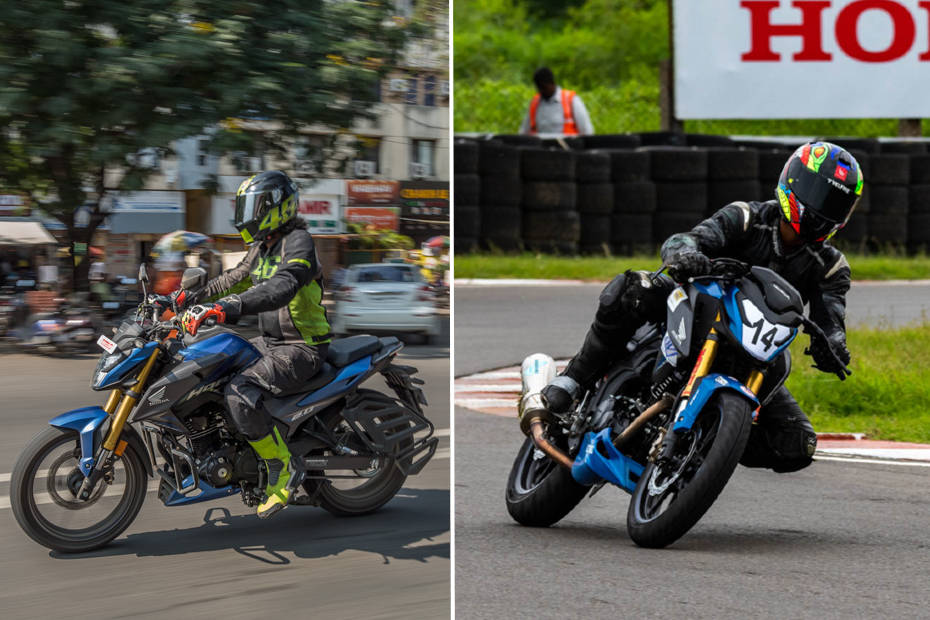Honda Hornet 2.0 Race Bike VS Stock Bike In 7 Pics
Modified On Jun 16, 2022 12:17 PM By Ishan Lee for Honda Hornet 2.0
- 1887 Views
- Write a comment
Checkout the modification required to turn everyday streetbikes into racetrack ready motorcycles

If you follow the Indian motor racing scene in India, you probably have heard of the Honda One Make Race. However, if you do not follow the racing scene you will be surprised how little modifications can turn a simple road going streetfighter into a corner-attacking track brawler.
Background into Honda One Make Race:

The ‘One Make Race’ (OMR) is an initiative by Honda Racing India, the Japanese bikemaker’s racing arm in the country. It is seen as a launchpad for young racing enthusiasts to try their hand at professional racing with the support of a manufacturer. For the OMR, the company offers a lightly modified Honda Hornet 2.0. Let’s have a look at what changes Honda has made to the Hornet 2.0 for it to be race-ready.
Design:
Stock:
The stock Honda Hornet 2.0 looks like a scaled down version of the old Honda CB600F, the OG Hornet. It gets a sporty LED headlight, flat handlebars, brawny fuel tank, chunty split seat design and a meaty subframe that gives it a proper streetfighter look.
Race:
You know how parents sent us to school in clean, well kept uniforms and by 4pm we came home looking like we went to war? The race bike looks like that 4pm version of the Hornet’s street going version. Same bike, but the handlebars have been turned upside down for an aggressive tuck, headlight and mirrors removed for track regulations and weight savings among other small parts, and pillion seat covered with cowl for better aerodynamics.
Engine:
Stock:
A stock Hornet has a 184.4cc, air-cooled, single-cylinder heart mated to a 5-speed gearbox, making a decent 17.27PS and 16.1Nm. The numbers may not impress on paper, however, the stock Hornet is pretty quick thanks to its low kerb weight of 142kg and short gearing.
Race: 
The race-spec Hornet on the other hand, despite running the same engine with the same 5-speed gearbox, puts down a bit more power. How? Well, for starters, it runs a full free-flow exhaust which not only lowers the kerb weight but also allows exhaust gases to escape faster. Result, the bike revs harder and faster. We also see a PowerTronic sticker on the motorcycle, which suggests the race bike could be running a custom fuel map. If so, these bikes could see a marginal gain in power too.
Suspension:
Stock:
The stock bike gets a USD fork and preload-adjustable monoshock. While set slightly on the softer side to handle urban riding and poor city roads, it also handles high-speed highway runs and some light cornering up mountain roads pretty well. It feels agile and surefooted.
Race:
The race bike has been seen wearing the same suspension setup but with Showa branding. While these units did not have the tuning screws that suggest they are fully adjustable, the internal springs and other components could be track focused. Furthermore, the setup may run a stiffer setting given its race bred mentality.
Brakes:
Stock:
Braking on the Hornet is handled by a single 276mm disc at the front and a 220mm disc at the back. It also gets single channel ABS for rider aid.
Race:
Braking hardware appears unchanged with the same single disc setup at the front and at the back. However, we suspect the ABS might be disengaged and the brake pads could be more specialised for extra bite and stopping force on the race track.
Sprocket:
Stock:
The stock motorcycle typically runs a sprocket setup that’s balanced for quick acceleration and relaxed highway riding. Stock sprockets are typically heavier but last longer too. We do not necessarily feel this weight given the overall urban setup of the bike. However, by changing a sprocket’s size and using a lighter unit can make a big difference to a motorcycle’s performance.
Race:
And this is exactly what Honda has done with the race Hornet. It is clearly seen running a lighter sprocket that could also have a few extra teeth to revise the gearing dynamics of the Hornet for better acceleration on the track.
Footpegs:
Stock:
The stock motorcycle gets a relatively neutral riding position with centrally positioned footpegs. This allows the rider to sit more comfortably on their daily commutes.
Race:
Race bikes demand a more committed riding position and hence, Honda has given the Hornet fully adjustable rear-set footpegs.
What’s interesting is how with little modification, Honda has been able to turn an already sporty motorcycle like the Hornet 2.0 into a track ready bike for novices and even intermediate riders. You can buy the Hornet for Rs 1,34,238 (ex-showroom Delhi).
